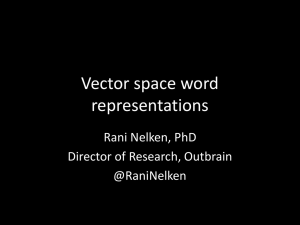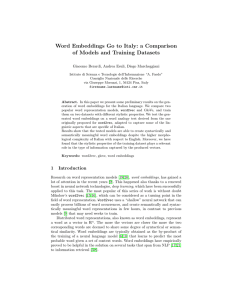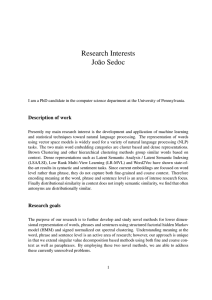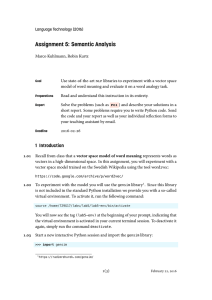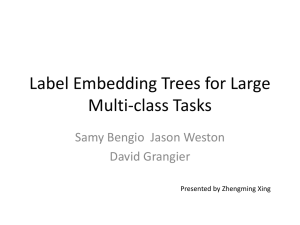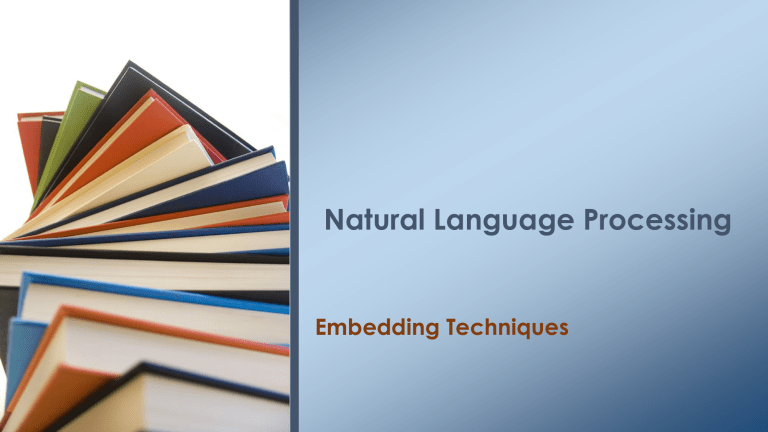
Natural Language Processing Embedding Techniques Outline • Introduction • Word2vec CBOW Skip-gram Relations Learned by Word2vec Language Modeling Negative Sampling Training Process • Gensim Word2vec Introduction • The concept of embeddings to be one of the most magic ideas in machine learning. • If you’ve ever used Siri, Google Assistant, Alexa, Google Translate, or even smartphone keyboard with next-word prediction, then chances are you’ve benefitted from this idea that has become central to Natural Language Processing models. • There has been quite a development over the last decade in using embeddings for neural models (Recent developments include BERT and ChatGPT). Introduction • We can proceed to look at trained word-vector examples (also called word embeddings) and start looking at some of their interesting properties. • This is a word embedding for the word “king” (GloVe vector trained on Wikipedia): • Source: https://jalammar.github.io/illustrated-word2vec/ Introduction • These vector representations capture quite a bit of the information, meaning, associations of these words. Introduction • Compare by vertically scanning the columns looking for columns with similar colors Introduction • The famous examples that show an incredible property of embeddings is the concept of analogies. • We can add and subtract word embeddings and arrive at interesting results. The most famous example is the formula: “king” - “man” + “woman”. • Using the Gensim library in python, we can add and subtract word vectors, and it would find the most similar words to the resulting vector. Introduction • The resulting vector from "king-man+woman" doesn't exactly equal "queen", but "queen" is the closest word to it from the 400,000 word embeddings we have in this collection. Word2vec • The word2vec algorithm uses a neural network model to learn word associations from a large corpus of text. • Once trained, such a model can detect synonymous words or suggest additional words for a partial sentence. • As the name implies, word2vec represents each distinct word with a particular list of numbers called a vector. • The vectors are chosen carefully such that they capture the semantic and syntactic qualities of words; as such, a simple mathematical function (cosine similarity) can indicate the level of semantic similarity between the words represented by those vectors. Word2vec • Introduced by Tomas Mikolov 2013 (then at Google 2014) • Represent each word with a low-dimensional vector • Words similarity = Vectors Similarity • Key idea: Don’t Count , Predict • Predict surrounding words of every word • Faster and can easily incorporate a new sentence/document or add a word to the vocabulary • Word meaning and relationships between words are encoded spatially • Neural Network approach (It is NOT Deep Learning) Word2vec • Two architectures were proposed: • Continuous Bag-of-Words model predicting the word given its context • Continuous Skip-gram model predicting the context given a word Word2vec: CBOW Word2vec: Skip-gram Relations Learned by Word2vec Relations Learned by Word2vec Relations Learned by Word2vec Relations Learned by Word2vec Relations Learned by Word2vec Relations Learned by Word2vec Word2vec (LM) • Language modeling (LM) is the use of various statistical and probabilistic techniques to determine the probability of a given sequence of words occurring in a sentence. • Language models analyze bodies of text data to provide a basis for their word predictions. • If one wanted to give an example of an NLP application, one of the best examples would be the next-word prediction feature of a smartphone keyboard. • “Thou shalt not make a machine in the likeness of a human mind” ~Dune Word2vec (LM) • Next-word prediction is a task that can be addressed by a language model. • A language model can take a list of words (let’s say two words), and attempt to predict the word that follows them. Word2vec (LM) • But in practice, the model doesn’t output only one word. • It actually outputs a probability score for all the words it knows (the model’s “vocabulary”, which can range from a few thousand to over a million words). • The keyboard application then has to find the words with the highest scores, and present those to the user. Word2vec (LM) • Calculating the predication through 3 steps: Word2vec (LM) • Calculating the predication through 3 steps: Word2vec (LM) • Words get their embeddings by looking at which other words they tend to appear next to. • The mechanics of that is that: We get a lot of text data (say, all Wikipedia articles, for example). Then We have a window (say, of three words) that we slide against all of that text. The sliding window generates training samples for our model. Word2vec (LM) Word2vec (LM) Word2vec • Fill in the blank : Word2vec (CBOW) • Instead of only looking two words before the target word, we can also look at two words after it. Word2vec (Skip-gram) • The word in the green slot would be the input word, each pink box would be a possible output. Word2vec (Skip-gram) Word2vec (Skip-gram) Word2vec (Skip-gram) Word2vec (Skip-gram) Word2vec (Skip-gram) Word2vec (Skip-gram) Word2vec (Skip-gram) Word2vec (Negative Sampling) Word2vec (Negative Sampling) Word2vec (Negative Sampling) Word2vec (Negative Sampling) • If all the examples are positive (target: 1), the possibility of a smartass model that always returns 1 – achieving 100% accuracy but learning nothing and generating garbage embeddings. Word2vec (Negative Sampling) • We need to introduce negative samples to our dataset – samples of words that are not neighbors. • The model needs to return 0 for those samples. • Now that’s a challenge that the model has to work hard to solve – but still at blazing fast speed. Word2vec (SGNS) • Skip-gram with Negative Sampling (SGNS) Word2vec (Training Process) • At the start of the training phase, we create two matrices: Embedding matrix , Context matrix • These two matrices have an embedding for each word in our vocabulary (So vocab_size is one of their dimensions, 10,000 for example). • The second dimension is how long we want each embedding to be (embedding_size – 300 is a common value). Word2vec (Training Process) • At the start of the training process, we initialize these matrices with random values. • Then we start the training process. • In each training step, we take one positive example and its associated negative examples. Word2vec (Training Process) • Now we have four words: the input word not and output/context words: thou (the actual neighbor), aaron, and taco (the negative examples). • We proceed to look up their embeddings – for the input word, we look in the Embedding matrix. • For the context words, we look in the Context matrix (even though both matrices have an embedding for every word in our vocabulary). Word2vec (Training Process) • Then, we take the dot product of the input embedding with each of the context embeddings. • In each case, that would result in a number, that number indicates the similarity of the input and context embeddings. Word2vec (Training Process) • Now we need a way to turn these scores into something that looks like probabilities. • We need them to all be positive and have values between zero and one. • This is a great task for sigmoid. Word2vec (Training Process) • Here comes the “learning” part of “machine learning”. • We can now use this error score to adjust the embeddings of not, thou, aaron, and taco. • So that the next time we make this calculation, the result would be closer to the target scores. Word2vec (Training Process) • We now proceed to the next step: (the next positive sample and its associated negative samples) and do the same process again. • The embeddings continue to be improved while we cycle through our entire dataset for several times. • We can then stop the training process, discard the Context matrix, and use the Embeddings matrix as our pre-trained embeddings for the next task. Word2vec (Training Process) • Two key hyperparameters in the word2vec training process are the window size and the number of negative samples. Word2vec (Gensim) Train the model: Word2vec (Gensim) Train the model: Word2vec (Gensim) Using the pre-trained model: NLTK includes a pre-trained model which is part of a model that is trained on Google News Dataset. The full model is from https://code.google.com/p/word2vec/ (about 3 GB). Word2vec (Gensim) Using the pre-trained model: Next Lecture Sent2vec Doc2vec Can we use word2vec to train a machine learning classifier?
